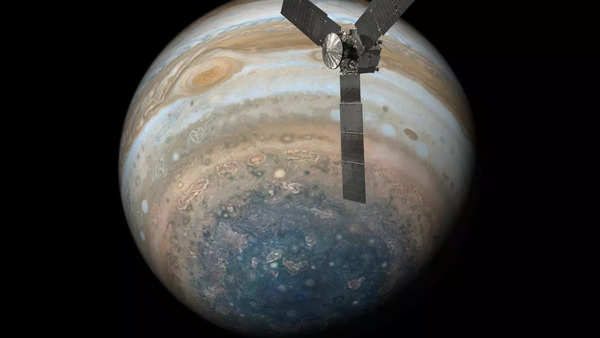The image, processed by citizen scientist Gary Eason, reveals the intricate structures within Jupiter’s cloud tops.Eason used raw data from the JunoCam instrument and applied digital processing techniques to enhance the color and clarity of the image. The result is a vivid depiction of the planet’s turbulent atmosphere, highlighting an area known to scientists as a folded filamentary region. In these regions, the zonal jets that create the familiar banded patterns in Jupiter’s clouds break down, leading to rapidly evolving turbulent patterns and cloud structures.

In this picture of Jupiter captured by Juno, the contrast between the bluish pole and the turbulent sand storms of the giant planet were beautifully captured. Source: Juno/NASA
At the time the raw image was taken, Juno was approximately 18,000 miles (29,000 kilometers) above Jupiter’s cloud tops, at a latitude of about 68 degrees north of the equator. This vantage point allowed for an unprecedented view of the planet’s northern hemisphere, providing scientists with valuable data to better understand Jupiter’s atmospheric processes.
Juno, a NASA space probe, was launched on August 5, 2011, as part of NASA’s New Frontiers program. The mission aims to study Jupiter’s composition, gravity field, magnetic field, and polar magnetosphere. By examining these aspects, scientists hope to gain insights into the planet’s formation and, by extension, the early history of the solar system. Juno entered Jupiter’s orbit on July 4, 2016, and has since been making close passes over the planet’s cloud tops to collect data.
The spacecraft is equipped with a suite of scientific instruments, including a microwave radiometer to peer beneath the dense cloud cover and a suite of cameras and sensors to map the planet’s magnetic and gravitational fields. These instruments have provided unprecedented views into Jupiter’s atmosphere, revealing intricate structures in the planet’s storms, bands, and auroras.
Juno’s mission has been extended several times, allowing it to continue its exploration of Jupiter. The spacecraft’s solar panels, a notable feature since it operates farther from the Sun than any previous solar-powered probe, have enabled it to sustain its mission for an extended period. The data collected by Juno has been invaluable in advancing our understanding of the largest planet in our solar system.
Citizen scientists like Gary Eason play a crucial role in the Juno mission. By processing raw images from JunoCam, they contribute to the scientific community’s understanding of Jupiter. These processed images are made available to the public, allowing anyone with an interest in space exploration to engage with the mission and contribute to its success.
Juno’s recent flyby and the stunning images it captured are proof of the spacecraft’s enduring capabilities and the collaborative efforts of scientists and citizen scientists alike. As Juno continues its mission, it promises to unveil even more secrets of Jupiter, enriching our knowledge of this fascinating giant planet.
Did you like this article? Please let us know in the comments below!
‘India Very Important’: Malaysian Minister Bats For Bolstering Food Security Pact | Watch

